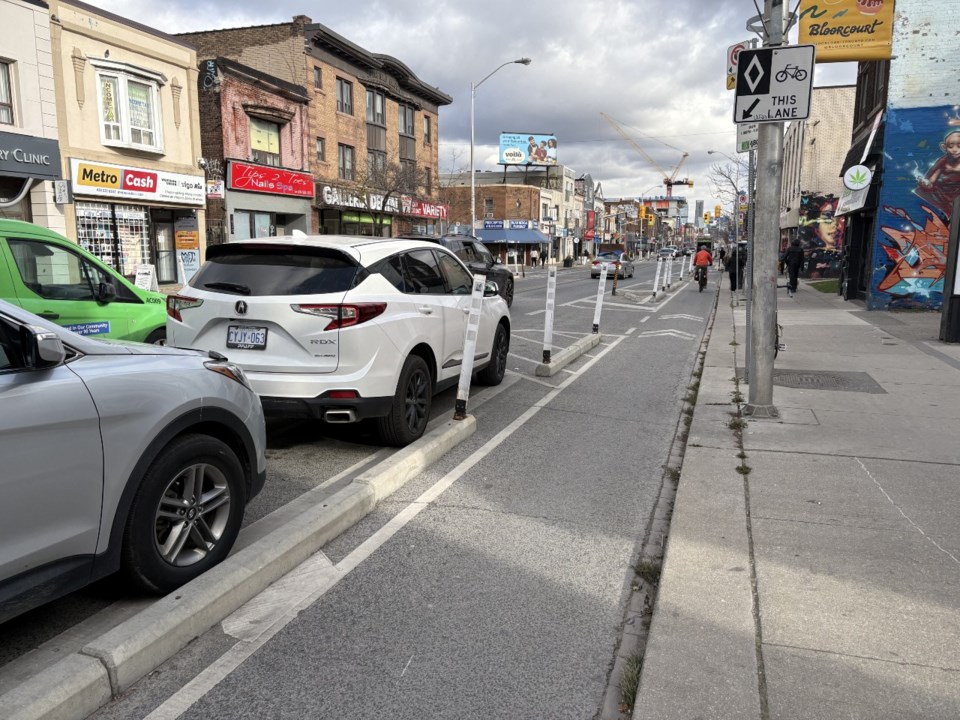Toronto’s bike lane expansion program is going full steam ahead despite the Doug Ford government’s legislation limiting the city’s powers.
According to a new proposal, city staff are recommending a $28.5-million project to build over 12 kilometres of new bike lanes.
The proposed new cycle paths won’t require removing lanes of vehicle traffic so they won’t run afoul of new provincial rules preventing cities from installing bike lanes at the expense of cars.
However, some of the plans do involve removing a small number of street parking spaces.
Michael Longfield, executive director of Cycle Toronto, a non-profit advocacy organization, said he’s encouraged the city is still plugging away at its cycling network.
“In the shadow of Bill 212 [the Ford government’s bill to limit bike lane expansion], the city is still proactive and moving forward,” he said.
If city council approves the report in March, the new lanes will be added across the city with construction starting as early as this year. One of the projects on Bedford Road in the Annex also includes watermain replacements.
Longfield said the highlight of the proposed changes is how they link to existing biking routes, offering cyclists more uninterrupted journeys.
“I think folks are realizing that kilometres are important with building out a cycling network, but arguably even more important is connectivity,” he said. “It’s not just a matter of building out a bike lane that goes to nowhere, it’s how you create connections within an existing network.
West end
New bike lanes projects are proposed for the west end and the Annex.
The first, which includes five different lanes, is in the Wallace Emerson neighbourhood nestled in between Bloordale and the Junction Triangle.
Hallam Street between Bartlett Avenue and Dufferin Street could see one-way lanes added on the north and south sides of the street, with 20 parking spaces removed on the south side.
Other new lanes could be added to St. Clarens Avenue between Wallace Avenue and Dupont Street, Millicent Street between Emerson Street and Dufferin Street, and Emerson Avenue between Bloor Street and Dupont Street. A short lane is also proposed on Wallace Avenue between Lansdowne Avenue and St. Clarens Avenue.
In the Annex, Bedford Street could see its existing bike lanes expanded further between Prince Arthur Avenue and Bloor Street, steps from the University of Toronto’s Varsity Stadium.
Lanes already exist on Bedford Street just south of Prince Arthur Ave and the proposed changes would make the entire street a cycling thoroughfare connecting Bloor Street to Davenport Avenue.

North Toronto
The biggest changes will come to Bathurst Street between Sheppard Avenue West and Steeles Avenue West, where staff are proposing nearly five kilometres of new bike lanes and multi-use trails.
The new lanes would connect to the existing cycling network in and around Earl Bales Park, the Finch Hydro Corridor and the Bathurst Manor neighbourhood.
“The Bathurst project will create lots of new connections for folks that are already using parts of the trail network up there and give them some street connectivity, as well,” Longfield said.
Bathurst Street is a major arterial road with two lanes of traffic in each direction. Around 30,000 cars use the street per day. Between 2012 and 2022, 36 cyclists were involved in collisions. Over the same period, 107 pedestrians were struck by cars, which resulted in 14 deaths or serious injuries.
Over half of the new bike paths will be separated from the sidewalk by grass, shrubs, or other green features. Vehicle traffic will also be separated from the bike lanes.
Construction on Bathurst Street between Steeles Avenue and Kingsbridge Court, just south of Finch Avenue, could start this year and continue into 2026.
The southern portion, between Finch Avenue and Bainbridge Avenue, will start construction after the first phase is done.
The Bathurst Street project isn’t the only change proposed to the northern parts of Toronto.
Further west, York Gate Boulevard could get new lanes between Jane Street and the Finch Hydro Corridor.
Staff suggest two one-way lanes on each side of the road — while retaining the existing lanes of traffic and sidewalks. Grass would separate the new lanes from both pedestrians and cars.
East end and Scarborough
In Cabbagetown, staff are proposing a new lane on Ontario Street from Wellesley Street to Winchester Park, which would connect to the existing Ontario Street lane south of the park, ending at Carlton Street.
Taken together, the new and existing lanes would give cyclists a clean route between Wellesley Street and Carlton Avenue, two major east-west roads in Toronto’s east end.
Further northeast into Scarborough, staff are proposing one new lane on Ellesmere Road between Orton Park Road and Kingston Road.
Longfield called it a “really nifty” project because, like the Bathurst Street one, it will connect several existing and planned trails.
